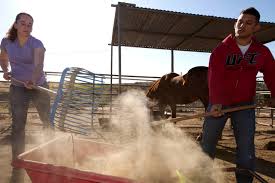I love having my horses in my back yard. Going out early (very early) every morning to greet and feed them, being able to pop out to the barn for a visit or a ride, being able to monitor their health and well-being on a daily or even hourly basis—it’s all good.
Of course, it doesn’t take much time as a back yard horse owner to figure out that, yeah, poop happens. A lot. The average horse produces about 45 pounds of poop a day, and that adds up fast. If you were to store it, you would need an area 12 x 12 feet, piled 3-5 feet deep, to store a year’s worth if it includes bedding. That’s around 16 cubic yards, and it could be more depending on the horse and how much bedding is used. Multiply that by the number of horses you maintain on your property, and it becomes clear that it’s a lot better to dispose of it than it is to store it.
I have to admit, I’ve been pretty slack about managing the manure supply. I’ve been piling it in a section of the pasture not subject to runoff and crossing my fingers that it will self-compost. Then, a couple times a year, after discovering that it will NOT self-compost, I use the tractor to spread it over another section of the pasture. This, by the way, is not ideal. It makes for an ugly pile, taking up pasture space, and since the horses have free access to it, I avoid adding compost-able items like grass clippings and vegetable waste from the house.
Aside from the aesthetics, horse manure plays host to flies and parasites. In addition, if not stored in an appropriate location, it can pollute local waterways. Local zoning requirements dictate how far away from a waterway manure can be stored, and obviously it should be in a place apart from where water flows through the property during heavy rainfall.
The main options for disposal are:
- Have it hauled off
- Spread it on a pasture area
- Compost it.
There are people who will haul it off. The garbage company, for one. You will need a dumpster and pay to have it emptied. Other options are farmers and vineyards. Many large stables use this option, and it may be an option for the small-parcel horse owner as well. Try contacting local farmers (vegetable or flower farms) or vineyards and see if they are interested, and then work out the logistics (Who hauls it? Who loads it? How often?). Local compost companies may be another option, although the main compost facility in our area doesn’t accept it.
Spreading (aka “land application”) is another option. Spreading an inch or so over pasture areas can improve the soil quality. As in storing, care should be taken that it does not run off into water sources. It can be spread as it is cleaned from the barn and paddocks, or accumulated and then use a tractor bucket or a manure spreader to spread it later. Nutrient composition can be spotty, and flies and parasites are still a problem.
My favorite, but harder to implement, solution is composting. This is a science unto itself, and I’m going to present a cursory explanation right now. This is the option I’ve selected, and that means I have a lot more research to do. But here are the bare-bones basics:
- Successful composting requires 4 things:
- Nitrogen
- Carbon
- Oxygen
- Moisture
- The ideal carbon:nitrogen ratio is 25:1 or lower
- Horse manure on its own (sans bedding) is close to that ideal ratio
- Bedding adds carbon and that tends to make the ratio too heavy on carbon for successful composting. Depending on how much bedding is included in the pile, the ratio can be as high as 75:1 as bedding is almost entirely carbon (C/N ratio 500:1)
- Oxygen can be added in a couple ways
- Frequent turning of the pile
- Static air flow (system of perforated pipes and a blower)
With all those factors present, manure can “hot compost” which will lead to destruction of parasites and their eggs and weed seeds, leaving you with a very desirable garden compost. The desired internal temperature of the compost pile is 131 to 150 degrees F.
Composting can be done with free piles on the ground, or in bins. Either way, there are usually 3 piles or bins, with manure in various stages of completed composting in each pile or bin. Once the compost is finished (broken down), the finished compost can be put on the garden or given away.
There is a lot more information on composting coming up, including descriptions of systems that can either be constructed or purchased, depending on your budget.

